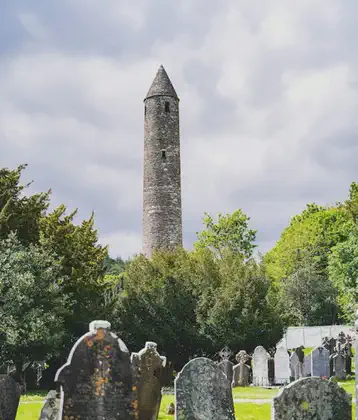
Saint Columba or Saint Colm Cille sometimes known as St. Columba of Iona (7 December 521 - 9 June 597), (Old Irish Columb Cille, meaning Dove of the church), was the outstanding figure among the Gaelic missionary monks who reintroduced Christianity to Scotland during the Dark Ages.
He was born to Fedlimid and Eithne of the Uí Néill clan in Gartan, near Lough Gartan, Donegal. On his fathers side he was great-great-grandson of Niall of the Nine Hostages, an Irish king of the 5th century. He became a monk and was ordained priest. Tradition asserts that, sometime around 560, he became involved in a dispute with Saint Finnian over a psalter. Columba copied the manuscript at the scriptorium under Saint Finnian, intending to keep the copy. Saint Finnian disputed his right to keep the copy. The dispute eventually led to the pitched Battle of Cúl Dreimhne in 561, during which many men were killed. (Columbas copy of the psalter has been traditionally associated with the Cathach of St. Columba.) As penance for these deaths, Columba suggested that he work as a missionary in Scotland to help convert as many people as had been killed in the battle. He exiled himself from Ireland and never again saw his native island.
In 563 he traveled to Scotland, where according to his legend he first landed at the southern tip of the Kintyre peninsula, near Southend. However, being still in sight of his native land he moved further north up the west coast of Scotland. In 563 he was granted land on the island of Iona off the west coast of Scotland which became the centre of his evangelising mission to the Scotland. Aside from the services he provided guiding the only outpost of literacy in the region, his reputation as a holy man led to his role as a diplomat among the tribes; there are also many stories of miracles which he performed during his work to convert the Picts.
The main source of information about Columbas life is the Vita Columbae by Adomnán, the ninth Abbot of Iona, who died in 704. Both the Vita Columbae and Bede record Columbas visit to Bridei, King of Fortriu. Whereas Adomnán just tells us that Columba visited Bridei, Bede relates a later, perhaps Pictish tradition, whereby the saint actually converts the Pictish king. Another early source is a poem in praise of Columba, most probably also composed in the course of the 7th century. It consists of 25 stanzas of four verses of seven syllables each.
The earliest recorded example of the name Arthur in a British document occurs, as Arturius, in Adomnans vita. There it occurs as the name of a prince among the Scots, the son of Áedán mac Gabráin, king of Dál Riata from AD 574, far from the legendary King Arthurs familiar haunts in the southwest.
The vita of Columba is also the source of the first known reference to the Loch Ness Monster. According to Adomnan, Columba came across a group of Picts who were burying a man killed by the monster, and saved a swimmer with the sign of the Cross and the imprecation You will go no further, at which the beast fled terrified, to the amazement of the assembled Picts who glorified Columbas God. Whether or not this incident is true, Adomnans text specifically states that the monster was swimming in the River Ness – the river flowing through the loch – rather than in Loch Ness itself.
Through the reputation of its venerable founder and its position as a major European center of learning, Columbas Iona became a place of pilgrimage. A network of Celtic high crosses marking processional routes developed around his shrine at Iona.
Columba’s relics were finally removed in 849 and divided between Alba and Ireland. Relics of Columba were carried before Scottish armies in the reliquary made at Iona in the mid-8th century, called the Brechbennoch. O Columba spes Scotorum… O Columba, hope of the Scots begins a 13th century prayer in the Antiphoner of Inchcolm, the Iona of the East.
St Columbas feast day is June 9 and with Saint Patrick, March 17, and St. Brigid, February 01, is one of the three patron saints of Ireland.
More From This Day


Coronation of King George VI and Queen Elizabeth took place at Westminster Abbey.
May 12, 1937

Irish Patriots, Seán MacDiarmada and James Connolly are executed at Kilmainham Gaol
May 12, 1916

Mary Browne from Roscommon becomes the first Ban Garda, a woman police officer.
May 12, 1905


Archibald Hamilton Rowan, nationalist and United Irishman, is born in London
May 12, 1751

The Black Watch regiment was commissioned under General Wade to police the Highlands.
May 12, 1725

Thomas Wentworth, English viceroy of Ireland and Earl of Stafford is beheaded
May 12, 1641
